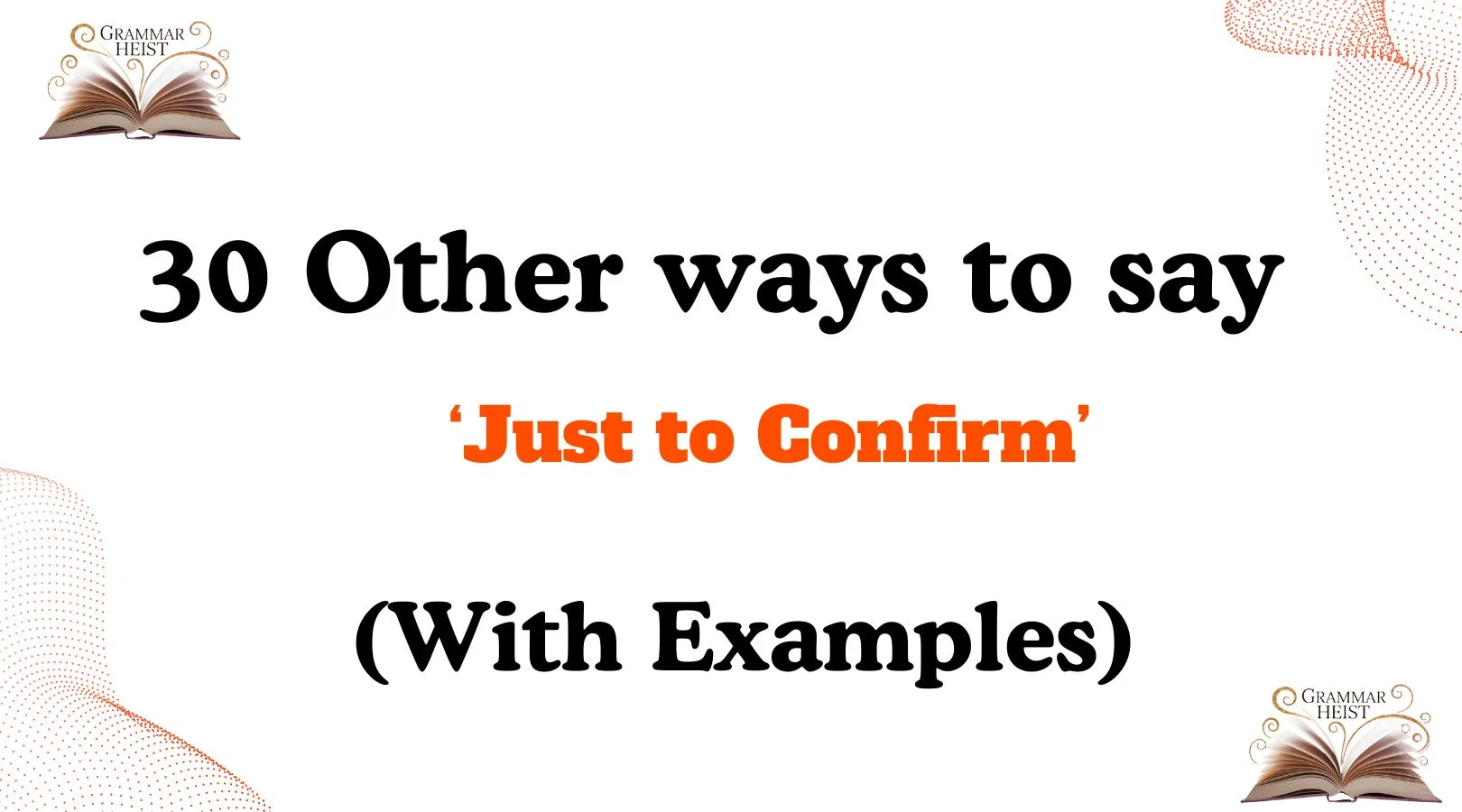Finding the right words to express clarity and care can make a big difference in how your message is received. Saying “just to confirm” is a polite and professional way to make sure everyone is on the same page — but repeating the same phrase over and over can sound robotic or impersonal. That’s why knowing other ways to say “just to confirm” can help you sound more thoughtful, warm, and natural in your communication.
Whether you’re writing an email, sending a text, or following up on a conversation, these 30 alternative phrases will help you communicate clearly and respectfully.
What Does “Just to Confirm” Mean?
The phrase “just to confirm” is often used to clarify information, avoid misunderstandings, and make sure both parties agree on the same details. It’s commonly used in professional settings, but it also works well in personal conversations where clear communication matters.
Example:
- “Just to confirm, our meeting is at 3 PM tomorrow, right?”
This phrase shows that you value accuracy and respect the other person’s time.
Is It Professional/Polite to Say “Just to Confirm”?
Yes — “just to confirm” is both polite and professional. It’s often used in emails, messages, and meetings to make sure everyone is aligned. However, using it too frequently can make your message sound repetitive or overly formal. That’s why learning alternatives can help you keep your tone fresh, natural, and engaging.
Pros and Cons of Using “Just to Confirm”
Pros:
- ✅ Clear and polite
- ✅ Widely understood
- ✅ Professional tone
Cons:
- ❌ Can sound repetitive if overused
- ❌ May come off as overly formal in casual settings
- ❌ Lacks emotional warmth compared to more personal phrases
Synonyms For “Just to Confirm”
- To make sure
- Just checking in
- Just making sure
- Just verifying
- To clarify
- Just to be certain
- To ensure
- Just double-checking
- Just confirming
- To reconfirm
- For clarity
- Just wanted to confirm
- Just to be clear
- Just touching base
- To make things clear
- Just circling back
- Just to verify
- To make it clear
- Just wanted to check
- Just to align
- To be sure
- Just cross-checking
- To avoid confusion
- Just a quick check
- Just checking with you
- Just to align our thoughts
- Just making it clear
- To confirm
- Just validating
- To reaffirm
1. To Make Sure
Scenario: You want to politely check that the other person remembers or agrees with the plan.
Examples:
- “To make sure, we’re meeting at 2 PM tomorrow, right?”
- “To make sure, the payment was processed on Monday?”
- “To make sure, your final decision is next week?”
Tone: Friendly and clear.
Explanation: This phrase keeps the conversation polite and smooth. It’s slightly less formal than “just to confirm” but still clear and professional.
2. Just Checking In
Scenario: You’re softly reminding or reconfirming something without sounding pushy.
Examples:
- “Just checking in, did you receive the report?”
- “Just checking in to see if you’re still available tomorrow.”
- “Just checking in — are we still good for the call?”
Tone: Warm and approachable.
Explanation: This is great for friendly follow-ups, especially when you don’t want to sound too strict or formal.
3. Just Making Sure
Scenario: You want to gently verify details or timing.
Examples:
- “Just making sure, you’re okay with the updated schedule?”
- “Just making sure we’re on the same page about this.”
- “Just making sure, the address hasn’t changed?”
Tone: Casual and warm.
Explanation: Works well in both professional and informal conversations. It keeps the tone light while confirming details.
4. Just Verifying
Scenario: You want to keep the tone slightly more formal, often used in work settings.
Examples:
- “Just verifying the meeting details.”
- “Just verifying your availability for tomorrow.”
- “Just verifying that the invoice has been sent.”
Tone: Professional and direct.
Explanation: Ideal for emails or business communication when clarity and precision are important.
5. To Clarify
Scenario: When there’s room for misunderstanding, and you want to clear things up.
Examples:
- “To clarify, the event starts at 5 PM, right?”
- “To clarify, you’ll be handling this part?”
- “To clarify, we’re meeting at the main office?”
Tone: Neutral and polite.
Explanation: This is excellent for professional communication where accuracy matters.
6. Just to Be Certain
Scenario: You’re making sure of something that is important or sensitive.
Examples:
- “Just to be certain, you’ve booked the venue?”
- “Just to be certain, the final approval is tomorrow?”
- “Just to be certain, we’re still going ahead?”
Tone: Slightly formal, polite.
Explanation: Shows carefulness and respect for details.
7. To Ensure
Scenario: Used when confirming something important to avoid errors.
Examples:
- “To ensure everything goes smoothly, you’ll handle the presentation?”
- “To ensure we’re aligned, I wanted to check this.”
- “To ensure we meet the deadline, can you confirm your part?”
Tone: Professional and clear.
Explanation: Common in workplaces where precision matters.
8. Just Double-Checking
Scenario: You want to confirm in a friendly, easygoing way.
Examples:
- “Just double-checking, the meeting is at 10 AM, right?”
- “Just double-checking, did you send the file?”
- “Just double-checking on your availability.”
Tone: Casual but respectful.
Explanation: Perfect for everyday communication to keep things smooth and light.
9. Just Confirming
Scenario: Very similar to the original phrase but slightly simpler.
Examples:
- “Just confirming, you’ll be joining the call?”
- “Just confirming your attendance tomorrow.”
- “Just confirming the final numbers.”
Tone: Neutral and polite.
Explanation: Works great when you want to keep it short and to the point.
10. To Reconfirm
Scenario: You already confirmed once, and now you’re checking again.
Examples:
- “To reconfirm, we’re still meeting on Friday?”
- “To reconfirm your flight details.”
- “To reconfirm the reservation is for two people.”
Tone: Polite and professional.
Explanation: This shows thoroughness and care.
11. For Clarity
Scenario: Used when ensuring mutual understanding.
Examples:
- “For clarity, we’re moving forward with option A?”
- “For clarity, the deadline remains Friday?”
- “For clarity, you’re okay with the changes?”
Tone: Clear and professional.
Explanation: Shows a thoughtful approach to communication.
12. Just Wanted to Confirm
Scenario: Polite and friendly check-in.
Examples:
- “Just wanted to confirm, you received my email?”
- “Just wanted to confirm your attendance.”
- “Just wanted to confirm the time.”
Tone: Warm and approachable.
Explanation: A classic and soft way to reconfirm something.
13. Just to Be Clear
Scenario: Used to make sure nothing is misunderstood.
Examples:
- “Just to be clear, we’re starting at 6?”
- “Just to be clear, this is the final draft?”
- “Just to be clear, I’ll handle the follow-up.”
Tone: Neutral to slightly firm.
Explanation: Keeps conversations focused and direct.
14. Just Touching Base
Scenario: When following up politely without pressure.
Examples:
- “Just touching base to see if you got my last message.”
- “Just touching base — are we still on for tomorrow?”
- “Just touching base on the proposal.”
Tone: Friendly and casual.
Explanation: Good for gentle reminders or check-ins.
15. To Make Things Clear
Scenario: Used to emphasize clarity and alignment.
Examples:
- “To make things clear, we’re going with plan B?”
- “To make things clear, you’re leading the session.”
- “To make things clear, it’s due Monday.”
Tone: Direct but polite.
Explanation: Shows a desire to avoid confusion.
16. Just Circling Back
Scenario: Commonly used in follow-up emails.
Examples:
- “Just circling back to see if you’ve had a chance to review.”
- “Just circling back on this topic.”
- “Just circling back — any update?”
Tone: Polite and professional.
Explanation: A soft, business-friendly way to nudge someone.
17. Just to Verify
Scenario: Used to reconfirm information.
Examples:
- “Just to verify, the files were uploaded?”
- “Just to verify, your availability is confirmed?”
- “Just to verify the delivery date.”
Tone: Formal and respectful.
Explanation: Works best in work or technical settings.
Read More:30 Other Ways to Say ‘I Don’t Know’ (With Examples)
18. To Make It Clear
Scenario: You want no misunderstanding at all.
Examples:
- “To make it clear, I’ll be sending the report tomorrow.”
- “To make it clear, this is the final version.”
- “To make it clear, your seat is confirmed.”
Tone: Direct and firm.
Explanation: Useful when clear communication is essential.
19. Just Wanted to Check
Scenario: Light, polite follow-up or confirmation.
Examples:
- “Just wanted to check if everything’s on track.”
- “Just wanted to check on your side.”
- “Just wanted to check you received the file.”
Tone: Friendly and approachable.
Explanation: Ideal for informal or semi-formal messages.
20. Just to Align
Scenario: Used to ensure both parties are on the same page.
Examples:
- “Just to align, we’ll meet at 3 PM?”
- “Just to align on priorities.”
- “Just to align, you’ll handle this part?”
Tone: Professional and collaborative.
Explanation: Common in team or project communication.
21. To Be Sure
Scenario: A polite, casual check.
Examples:
- “To be sure, this is the correct file?”
- “To be sure, we’re meeting on Tuesday?”
- “To be sure, you’re still available?”
Tone: Light and easy.
Explanation: Friendly and clear, great for casual or formal settings.
22. Just Cross-Checking
Scenario: A second verification or follow-up.
Examples:
- “Just cross-checking your details.”
- “Just cross-checking the numbers.”
- “Just cross-checking the date.”
Tone: Professional and precise.
Explanation: Shows attention to detail.
23. To Avoid Confusion
Scenario: Used to keep everyone on the same page.
Examples:
- “To avoid confusion, the meeting is at 11.”
- “To avoid confusion, I’m confirming the location.”
- “To avoid confusion, here’s the final plan.”
Tone: Neutral and clear.
Explanation: Great when communication involves multiple people or steps.
24. Just a Quick Check
Scenario: Very soft and polite check-in.
Examples:
- “Just a quick check, are you still joining?”
- “Just a quick check on the delivery.”
- “Just a quick check — everything good?”
Tone: Warm and light.
Explanation: Ideal for casual reminders or gentle nudges.
25. Just Checking with You
Scenario: Soft personal confirmation.
Examples:
- “Just checking with you — is everything ready?”
- “Just checking with you about the update.”
- “Just checking with you before I proceed.”
Tone: Friendly and caring.
Explanation: Sounds personal and respectful.
26. Just to Align Our Thoughts
Scenario: Used to emphasize teamwork and shared understanding.
Examples:
- “Just to align our thoughts, here’s the plan.”
- “Just to align our thoughts, we’ll go with this option.”
- “Just to align our thoughts, what’s your take?”
Tone: Collaborative and warm.
Explanation: Excellent for team discussions or brainstorming.
27. Just Making It Clear
Scenario: You want to state something clearly to avoid misunderstanding.
Examples:
- “Just making it clear, the deadline is tomorrow.”
- “Just making it clear, we agreed on this date.”
- “Just making it clear, I’ll handle it.”
Tone: Firm but polite.
Explanation: Good for clarity and accountability.
28. To Confirm
Scenario: Simple, short, and direct.
Examples:
- “To confirm, we’re meeting at 5?”
- “To confirm your attendance.”
- “To confirm, the package has arrived?”
Tone: Professional and brief.
Explanation: Perfect for quick, no-frills messages.
29. Just Validating
Scenario: Used to verify or reconfirm something technical or procedural.
Examples:
- “Just validating your request.”
- “Just validating that the data is correct.”
- “Just validating the booking.”
Tone: Professional.
Explanation: Excellent in business or technical communication.
30. To Reaffirm
Scenario: You want to gently but confidently restate something agreed on.
Examples:
- “To reaffirm, our deadline is Friday.”
- “To reaffirm, we agreed to move forward.”
- “To reaffirm, the schedule remains the same.”
Tone: Clear and respectful.
Explanation: Adds confidence and reassurance to your message.
📝 Conclusion
Finding other ways to say “just to confirm” gives your communication a fresh, thoughtful, and more human touch. Whether you’re writing a formal email or texting a friend, the right words can make your message sound more personal, caring, and clear.
Key tip: Choose your phrase based on the tone you want to set — professional, warm, friendly, or firm.

Emma Brooke is a passionate advocate for effective communication and language mastery. As a dedicated professional in the field of grammar and writing, Emma brings a wealth of knowledge and expertise to those seeking to improve their linguistic skills. With a focus on clarity, precision, and style, Emma Brooke is committed to helping individuals refine their language use to communicate confidently and effectively.












